Business Reviews and SEO: How Online Reviews Give B2B Companies a Boost in Organic Search
Sometimes, a good SEO tactic has nothing to do with optimizing your website. Many important, mid-funnel and purchase-intent B2B keywords—“best X,” “top X,” and “compare X vendors”—are highly unlikely to populate individual brand landing pages in top results.
On- and off-page SEO will not improve rankings if a page’s content doesn’t satisfy user intent, and the intent behind these keywords is usually to read third-party comparisons and customer reviews. In fact, more than 50% of B2B decision-makers conduct research on third-party sources before reaching out to a specific brand.
For many of these keywords, the most effective approach is to focus on increasing the number of positive reviews on high-ranking third-party sites. When users want product comparisons, that’s what Google will deliver, so good B2B SEO is about discovering the online review resources that are ranking well and getting your brand on the list. This boosts brand visibility and drives referrals, providing increased traffic, leads, and revenue.
How Reviews and Review Sites Help you Rank for Keywords You’d Otherwise Never Rank For
Start by identifying the most promising opportunities. Compile a list of five to 10 of your most important, unbranded keywords—those that are core to your business, the most likely to convert, and/or have the highest monthly search traffic.
Next, conduct a depersonalized search for each of the keywords on the list. Review the results for each keyword, and record those that generate primarily third-party review, rating, and comparison results.
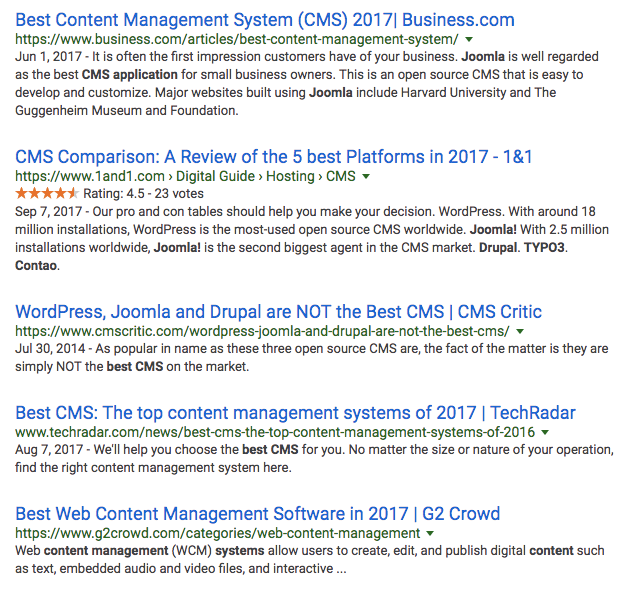
All of the page-one results for the keyword “best content management systems” are either third-party rating sites or comparative blog posts.
If basic keywords aren’t producing many third-party comparison results, add terms like “best” or “top” to the beginning of the keyword, and/or “software,” “tools,” or “providers” to the end, and check organic search results for two factors:
- Third party lists. Make sure they’re showing up now.
- Identical results. If “best” and “top,” for example, return very similar lists of organic results, Google gets you. If “software” and “platform,” however, return two fairly distinct sets of organic results, check search volume and the relevance of organic results for each keyword, so you can focus on the best option.
Now you’re ready to determine which specific sites to focus on. As you search each keyword, take note of the following information:
- What sites appear in top results? Record the names of each site that appears on page one of results or—at a minimum—in the top three results.
- What is the format of the results? Are results blog posts written by individual authors, lists of products and user reviews on third-party ratings sites (ex: G2 Crowd), or in-depth reports published by market research firms (ex: Gartner’s Magic Quadrant)? Record the format of top results alongside site names.
- How is the information gathered? Look for information related to how brands/products/services were selected, and determine if reviews are written by individual authors or populated from user-generated content.
Use this information to refine your initial prioritization.
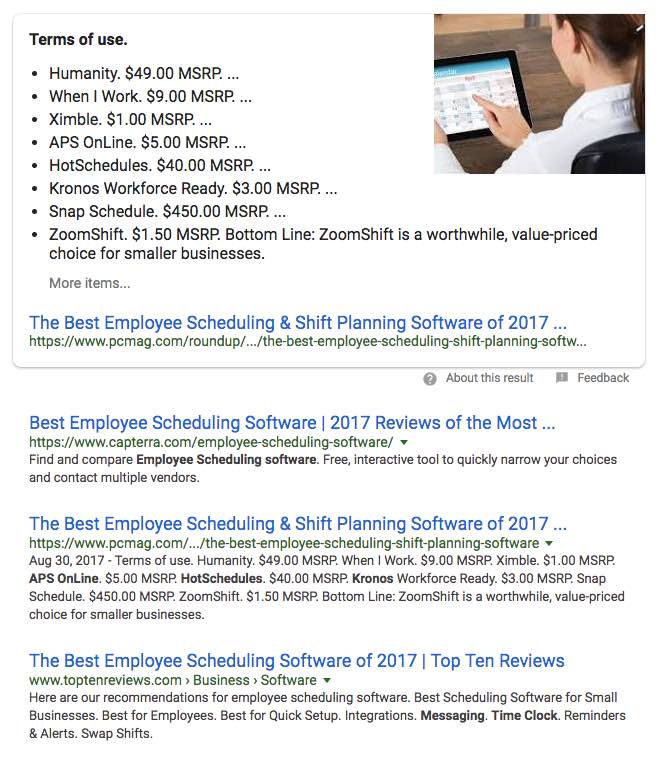
Organic results for “best employee scheduling app” are all third-party reviews. (1) Ranked at the top are Humanity (in the featured snippet), When I Work, and Ximble. (2) All of the top results are reviews from authoritative brand websites. (3) Most of the sources leading in rankings determine their “best” by user reviews or a very strict set of capabilities.
If the number one result for your most important keyword is a blog post written by an independent author/publisher, making that publisher aware of your product may be a top priority. If a featured snippet appears, the source is definitely a priority. Here, Marketo earns what amounts to the top spot for “best marketing automation companies” because of a third party review:
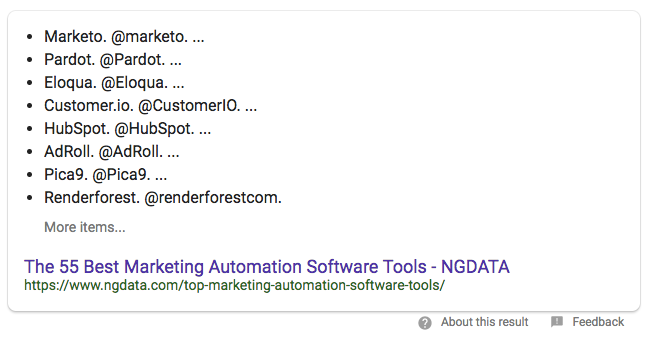
A featured snippet listing eight different products appears for the keyword “best marketing automation companies.” The snippet is provided by a blog post published on the site NGDATA.
Prioritize your list of opportunities, and focus efforts on the highest priority item first.
1. Ask to Be Included in Lists, Reviews, and Comparisons
If your brand is missing from the list of products on the site that represents your most promising opportunity, take steps to get on the list:
- If the opportunity is a ratings site, look for instructions on how to submit new listings. The details are often included within the content. If not, conduct a search for “how to add a [company/brand/product] to [name of site].”
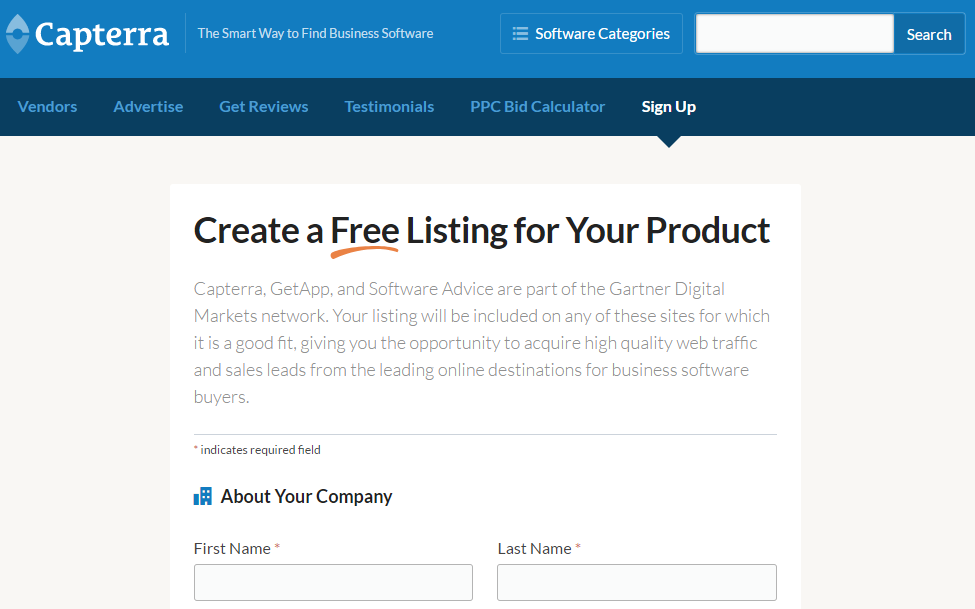 Capterra provides a form that allows brands to add product listings to its site.
Capterra provides a form that allows brands to add product listings to its site. 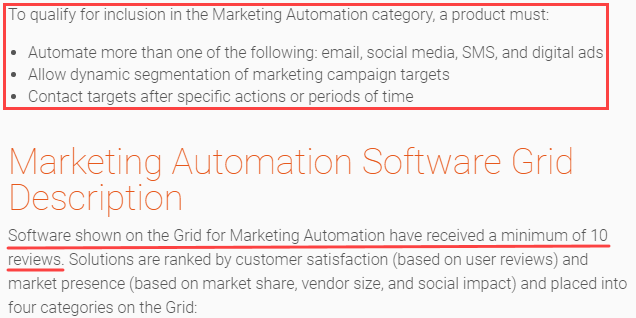
G2 Crowd provides very specific inclusion requirements for appearing on its marketing automation software grid. - If the opportunity is a blog post, look for contact details for the author, an editor, or the publisher. Send an email offering a free trial or subscription of your product that can be used for researching and reviewing it, and ask if the author would consider including it in the post.
- If the opportunity is a market research report, figure out how companies are selected for inclusion. In some cases, the report may have been commissioned by a competitor. In other cases—such as Gartner Magic Quadrant and Forrester Wave reports—independent analysts select the products to include based on certain criteria. This usually means there’s no way to influence inclusion, though becoming a client of the firm may help build brand awareness with analysts.
For blog posts and market research reports, work for that opportunity is complete once a positive review or mention is included. But for rating sites, a listing is not enough. To optimize the listing, customers must leave positive reviews on the site.
2. Request Reviews from Satisfied Customers
Increasing the number of reviews of your company, product, or service on third-party sites is crucial for three reasons:
- On many third-party B2B rating sites, the order of how products are listed corresponds to the number of user reviews and the overall aggregate rating. The brand with the highest number of positive reviews appears first in the list.
- Even on sites where the listing order is controlled by ad spend rather than number of reviews, having a high number of reviews is beneficial. Each additional review a company gets drives an average of almost 20 additional website visits per month.
- A high number of positive reviews provides obvious social proof. The legitimacy of three positive reviews is questionable—those could have been written by company owners, friends, or employees. But it would be very difficult to fake hundreds of positive reviews. The more reviews you have, the more trust readers will have in the validity of overall ratings and individual reviews.
While it’s generally unethical to offer an incentive to customers to write positive reviews, there’s nothing wrong with asking account contacts to write reviews on a specific site. Clients who’ve had positive experiences will often be happy to share their thoughts and experiences in a review.
There are many ways to request reviews—both subtly and directly:
- Include the request in company email signatures. If individual contributors commonly interact with customers by email, consider adding a request for a review—and a link to the review site—in email signatures.
- Include the request in marketing emails/newsletters. It doesn’t have to be the central topic—a sidebar or callout is sufficient.
- Include it in follow-up communications with new/renewing customers. If standard practice includes following up with new or recently renewed customers, this communication can be the perfect place to request a review.
- Add a promo to your website/app. Ideally, include it in a section that’s secured and accessible only to existing customers.
Finally, encourage team members to request reviews when talking to customers in person or over the phone. When a customer expresses satisfaction with your product or customer service, it creates an easy opening for a review request.
3. Add a Review Section to Your Website
B2B brands commonly focus on providing customer testimonials and case studies, leaving reviews to B2Cs. But reviews are also important in B2B: 93% of B2B buyers say reviews factor into their purchasing decisions.
Including a review page on your site provides a chance to rank for “[brand] reviews” keywords, and it appeases the need for prospects to access reviews without having to leave your site. Create a page for reviews, allow customers to submit reviews through an on-page form, and consider including some third-party reviews as well. Also consider marking up the review page with structured data to earn an aggregate rating snippet in search results.
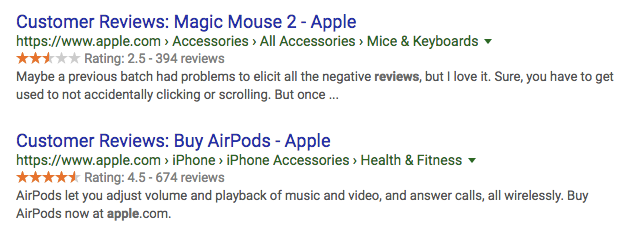
Not strictly a B2B company, but Apple has a detailed review section on their site that even allows users to enter star-based ratings. Google loves that kind of quick, easy value-add content.
As a bonus, the reviews that customers leave can be used to find new testimonial text to highlight on other site pages, and it may even provide opportunities to reach out to customers for building case studies.
The Importance of Business Reviews for B2B SEO
SEO is ultimately about increasing traffic, awareness, leads, and revenue. In some cases, this is achieved by increasing positive review counts on third-party sites, which improves the likelihood that prospects will find you when conducting initial and comparative research.
Get started by conducting some research on core keywords and identifying promising opportunities. This allows you to focus efforts on the places where positive reviews are most likely to increase site traffic and boost brand visibility.
What's Next?
Profound Strategy is on a mission to help growth-minded marketers turn SEO back into a source of predictable, reliable, scalable business results.
Start winning in organic search and turn SEO into your most efficient marketing channel. Subscribe to updates and join the 6,000+ marketing executives and founders that are changing the way they do SEO:
And dig deeper with some of our best content, such as The CMO’s Guide to Modern SEO, Technical SEO: A Decision Maker’s Guide, and A Modern Framework for SEO Work that Matters.




